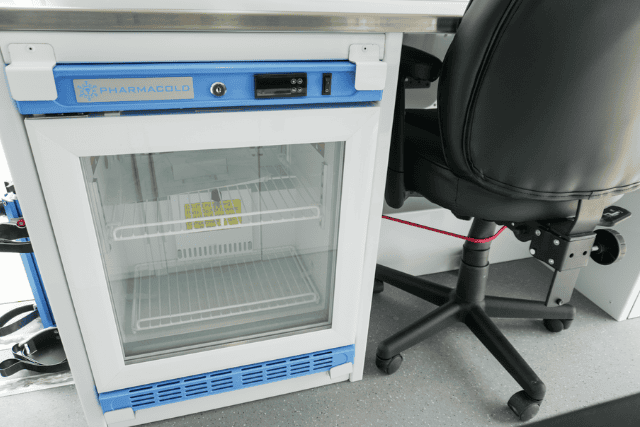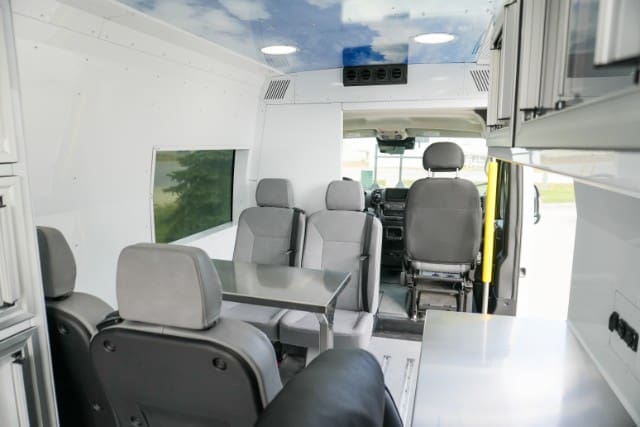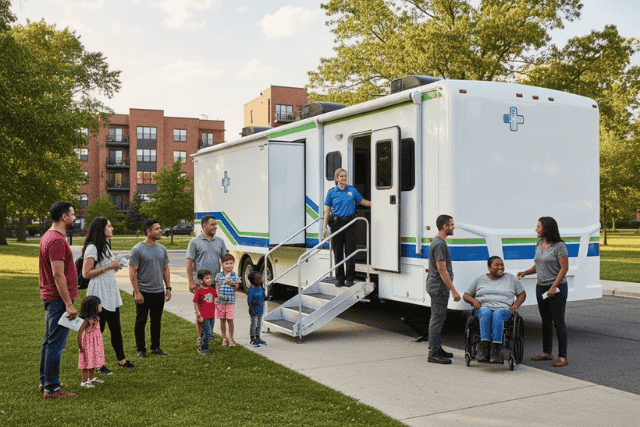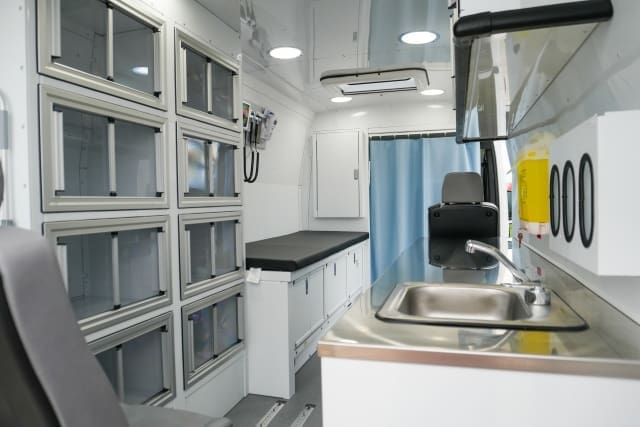Did you know nearly 25% of rural Americans skip healthcare because of distance? That’s a gap your organization is likely trying to close with a mobile health vehicle. But occasionally, one big question pops up: how does medication storage work? You’re thinking about keeping vaccines cold, securing narcotics, and staying on top of regulations. If medication storage fails, patients suffer. So does your program’s reputation. That’s a lot of pressure on your shoulders.
You might be a clinic manager, health director, or someone leading a community program. You worry about wasted medications, failed inspections, and putting patients at risk. We see you. You want a reliable mobile healthcare unit, one where you don’t panic about a fridge quitting or medication getting stolen. You want to focus on helping people, not fixing preventable problems.
At AVAN Mobility, we’ve spent over 10 years building mobile medical vehicles that break down healthcare barriers. We work with healthcare networks, governments, and non-profits all over the U.S. We also know we’re not the only ones out there, so we aim to simply share what we’ve learned.
After reading this article, you’ll have a better idea of how:
- Medication storage works in a mobile health unit
- Figuring out the right medication storage
Why is medication storage so important in mobile health vehicles?
When your mobile health unit hits the road, it might carry critical medications that must stay safe and effective. Some medications do fine at room temperature, around 59 to 77°F (15 to 25 °C). Think birth control pills, inhalers, and many antibiotics. Others need cooler temps, around 36 to 46 °F (2 to 8 °C), like insulin, vaccines, and certain biologic drugs. Mix that with hot U.S. summers, bumpy roads, and long trips into rural areas, and you’ve got a serious challenge.
Why it matters:
- Potency drops: Diazepam loses about 25 percent of its strength when it heats over 98 °F. Lorazepam can lose up to 75 percent.
- Emergency medications: Epinephrine, used to treat severe allergic reactions, can lose 64 percent of its power if stored incorrectly.
- Cold chain demand: Nearly 45 percent of top U.S. drug sales come from medications that require refrigeration, and that trend is only growing.
Studies show that more than half of refrigerated medications are stored incorrectly at home. Imagine that risk in a mobile medical clinic driving through rural Texas or remote Montana. Bad storage wastes money, puts lives at risk, and shakes trust.
Next, you’ll get a look at how medication storage works inside mobile health vehicles.
How does medication storage work in a mobile health vehicle?
So, how does medication storage actually work inside a mobile health vehicle? It’s not much different from your brick-and-mortar clinic’s setup, just packed into a smart, road-ready design. From specialized fridges to secure cabinets, your mobile healthcare unit can be tailored to handle everything from everyday pills to temperature-sensitive vaccines. It all depends on what you plan to deliver out there.
Let’s look at how you can set up your mobile medical clinic with a fridge that keeps medications safe and patients protected.
Customizing your mobile health vehicle with a fridge

If your program plans to carry vaccines, insulin, or biologic medications, you’ll need a fridge inside your mobile health vehicle. Simple as that. But this isn’t the same as your breakroom fridge. Medical-grade refrigerators are built to keep a steady 36 to 46 °F (2 to 8 °C) no matter where you’re parked. That could be under the hot Texas sun, at a busy county fair in Mississippi, or out on a dusty backroad in Idaho.
- Consistent temperatures: Unlike household fridges that can swing 10 degrees either way, medical units stay locked within a tight 2-3 degree range, so your vaccines and meds stay safe.
- Reliable on the road: Medical refrigerators are built to handle bumps, vibrations, and uneven parking spots. Your delicate supplies stay protected no matter where you set up.
- Power flexibility: Many medical fridges can run off your vehicle’s battery or an onboard generator. That keeps your medications cold even if you’re hours from the nearest plug.
You can also pair your mobile healthcare unit with a generator. That means if your engine shuts off at an outreach stop or you’re parked for hours serving a long line of patients, your fridge stays powered and your medication stays protected.
We help figure out the best spot for your fridge inside your mobile medical clinic. No one wants to climb over gear to reach a life-saving medication. Your fridge should be secure, easy to reach, and safe from bumps and hard stops.
Having the right fridge setup protects patients, saves money, and builds trust. It also makes your job a whole lot easier, so you can keep your focus on healthcare first.
Customizing your mobile health vehicle with cabinetry
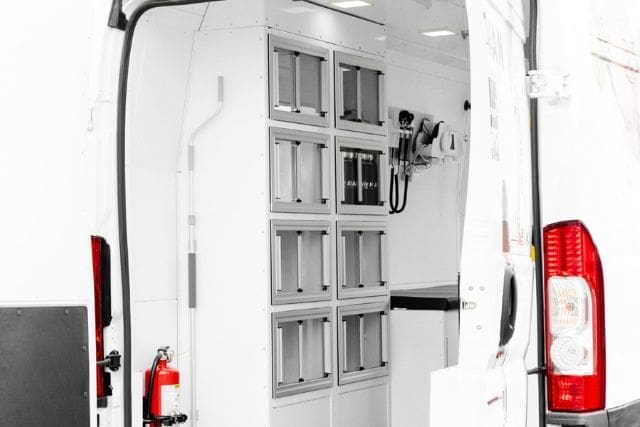
Not all medication needs refrigeration. Plenty of treatments and prescriptions can sit at room temperature inside your mobile health vehicle without a problem. This means you can save fridge space for the medication that truly needs it. Plus, it gives you more flexibility in how your mobile medical clinic is laid out.
As we mentioned earlier, many common medications stay stable between 59°F and 77°F (15 to 25 °C). Think oral antibiotics, blood pressure pills, or even many kinds of pain relievers. This means you can keep them in secure cabinetry instead of tying up costly fridge space. That’s a big help, especially for community programs that carry a wide range of supplies.
Secure cabinetry options:
- Locked floor-to-ceiling cabinets: Great for storing higher volumes of medication in your mobile healthcare unit. They’re tall, sturdy, and can be locked to keep medication secure even on bumpy roads.
- Overhead cabinetry: This type of cabinetry is perfect for lighter loads or quick-grab items. It is also lockable, so you can keep everything safe from theft or curious hands.
- Tinted or solid doors: If you want extra privacy, we can build cabinetry with tinted panels or fully solid doors. These doors keep what’s inside hidden from plain sight, adding a layer of protection and peace of mind.
You’ll still be meeting U.S. regulations that require secure storage, and you’ll be organizing your mobile medical vehicle for the way your team actually works. When medications are easy to reach and safely locked up, staff spend less time hunting around and more time caring for patients.
This flexibility means your mobile clinic feels less cramped, safer, and better suited for the real-world demands you face every day.
How do you keep medication secure and compliant in a mobile health vehicle?
So you’ve figured out the fridge, the cabinetry, and how to keep medication at the right temperature. But what about keeping it all secure and compliant inside your mobile health vehicle? If you’re carrying controlled substances or expensive medications, you’ve got more than just patient care on the line. You’re also dealing with DEA rules, state pharmacy laws, and your own peace of mind.
Here are a few things you can create:
- Access logs: Keep detailed records of who handles or dispenses medication and when. Some states require this by law, and even when they don’t, it’s a smart way to protect your team and patients.
- Audit trails: Regular reviews of your logs can catch errors or unusual patterns before they turn into bigger problems. They also give you solid documentation if you’re ever audited.
- Chain-of-custody procedures: Set clear expectations on how medications move from delivery to storage to the patient. This limits mistakes and protects everyone involved.
- Controlled substance counts: Routine checks (daily, weekly, or by shift) ensure nothing goes missing. If you’re carrying narcotics, this is typically mandatory.
- Policies: Decide exactly who can handle medications and outline their responsibilities in writing. This cuts down on confusion and makes sure your entire team is on the same page.
Safe storage and a solid plan keeps you compliant, protects your patients, and lets you focus on what matters most: reaching people who need care.
How do you plan the right medication storage for your mobile health vehicle?
By now, you probably see there’s no one-size-fits-all approach to medication storage in a mobile health vehicle. It all comes down to what your team does, where you go, and how you deliver care. Planning ahead is the best way to avoid expensive surprises later.
Start with what you’re offering:
- If you’re running immunization clinics or diabetes screenings, you’ll need a fridge for vaccines and insulin.
- If your focus is wound care or basic screenings, locked cabinetry might be enough.
- If you plan to keep controlled substances on board, you’ll need secure storage that meets state or DEA rules.
Think about your climate and routes:
A mobile medical unit in Arizona or Florida faces very different challenges than one in Minnesota. If you’re traveling long distances or parking in the heat for hours, that pushes a stronger case for top-tier refrigeration and maybe even more insulation.
Factor in your workflow:
Ask how your staff moves inside the mobile healthcare unit. You want quick access to medication without blocking hallways or crowding patient areas. Custom layouts can give you dedicated medication zones, with clear separation from general supplies.
Get your questions lined up:
- What medication will you carry most often?
- How many patients do you expect per day?
- Do local rules have special storage requirements?
- Who on your team will have access?
Planning right from the start saves you money, stress, and protects your patients long down the road.
Want to learn more about medication storage in mobile clinics?
You probably came to this article wondering how medication storage works in a mobile health vehicle. Maybe you felt worried about keeping vaccines at the right temperature, protecting controlled substances, or staying on top of rules. That’s normal. Your patients and staff count on you to get this right.
After reading this, here’s what you learned in a nutshell:
- Room temp vs. refrigerated: Some medication can be safely stored in secure cabinets, while others need a medical fridge to stay effective.
- Safe and smart setups: From locked floor-to-ceiling cabinetry to secure fridges, there are plenty of ways to keep medication safe, organized, and compliant.
- Planning ahead pays off: Knowing what you’ll carry, your climate, and your workflow helps avoid costly surprises down the road.
At AVAN Mobility, we’ve helped health teams, nonprofits, and government agencies across the U.S. design mobile medical vehicles that truly fit their goals. Our experts dig deep to learn about your program and build a clinic that protects medication and supports patient care every mile you drive.
Our friendly team believes healthcare should meet people where they are. That’s why we’re leaders in this industry. If you have questions or just want to brainstorm ideas, click below to talk to one of our mobility experts.
If you’re not ready to chat yet, we’ve got more helpful reads to keep you moving forward:
- How much does a mobile medical unit cost in the U.S.? This will give you a clear picture of what kind of investment you’re looking at for your mobile clinic.
- 5 types of mobile medical vans: See what types of mobile medical vehicles are out there so you can match the right build to your program’s needs.
- Buying a mobile medical van – Your process with AVAN Mobility: Learn exactly what the buying process looks like so you know what to expect every step of the way.
